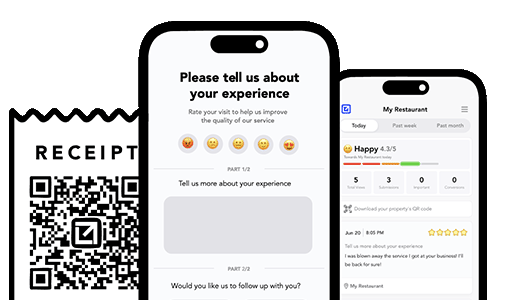Smart Ways to Get More Reviews [Guide]
Practical, proven ways for any business to get more authentic reviews.

TLDR: Every small business needs reviews, but most don’t know how to ask without sounding awkward, or worse, breaking Google’s rules. This article lays out five completely free and Google-compliant strategies for increasing your local review count fast. You’ll learn the best times to ask customers, how to integrate subtle review prompts into your emails and receipts, and how to leverage QR codes and social media to spark more positive reviews. We’ll also share a simple technique that rewards customers without violating any terms, and a bonus method that filters feedback before it goes public, so you get fewer bad reviews and more 5-star ones. Whether you run a cafe, salon, gym, or boutique shop, these tactics will help you build your online reputation without spending a dime.
If you rely on word-of-mouth, walk-ins, or local search to keep your business going, reviews aren’t a “nice to have”, they’re your lifeline. A strong collection of Google reviews boosts your visibility, improves your click-through rate, and builds instant trust with new customers.
But many small business owners feel stuck. They don’t want to beg for reviews, and they definitely don’t want to risk getting penalized by Google. Good news: there are several free, effective, and completely legit ways to gather more reviews, without awkwardness or rule-breaking.
Timing is everything. The best time to ask for a review is when your customer is already feeling good, right after a great haircut, a delicious meal, or a smooth checkout. That’s when people are most likely to say yes and leave something thoughtful.
The key here is emotion. Don’t just wait until the end of the transaction, wait until the moment you’ve made someone’s day. Then ask casually: “Would you mind leaving us a quick review on Google? It really helps.” That one question, when timed right, can double your chances.
QR codes are a frictionless way to collect reviews without needing your customer to type anything. Post one near your register, print it on receipts, or display it in your waiting area. The trick is to make it feel optional, not pushy.
Even better? Use a short, branded URL with it, like “mybusiness.com/review”, so if they don’t scan it, they can still get there easily later. Tools like Bit.ly or Google’s campaign URL builder can help you generate and track links for free.
You don’t have to make a big speech every time. A simple “Thanks for your visit, if you enjoyed it, we’d love a quick Google review” at the bottom of your receipt or in a follow-up email goes a long way. It plants the idea and gives them a path to act.
This method works especially well if you run a high-volume business like a coffee shop or boutique store. You’re creating review prompts at scale, without doing anything extra.
Post photos or stories of happy customers (with permission), and use the caption to subtly remind others to leave a review. For example: “We loved helping John get ready for his wedding, if you’ve had a great experience with us too, we’d be honored if you’d leave a review on Google!”
This makes the review request feel like a celebration, not a chore. Plus, it builds social proof by showing your followers that real people love what you do.
Google prohibits offering rewards in exchange for positive reviews, but you can offer small tokens of appreciation for any review, positive or not. That might mean a sticker, a coupon, or entry into a giveaway.
The key is transparency. Say something like: “Leave us a review, good, bad, or in between, and we’ll say thanks with a free coffee sleeve.” It encourages honest feedback and builds goodwill.
The best reviews come from your happiest customers, but how do you make sure it’s them leaving the public reviews?
The answer: use a tool that captures feedback privately first. That way, you can fix complaints in-house and gently nudge your best customers to leave a review publicly. It’s a win-win: more honest feedback, fewer surprises, and a steady stream of 5-star reviews that reflect your actual strengths.

Bad reviews can scare away potential customers. Intercept feedback in real time with VisibleFeedback.

Austin Spaeth is the founder of VisibleFeedback, a simple tool that helps brick-and-mortar businesses intercept negative reviews before they go public. With a background in software development and a passion for improving customer experience, Austin built VisibleFeedback to give business owners a frictionless way to collect private feedback and turn unhappy visitors into loyal advocates. When he’s not working on new features or writing about reputation strategy, he’s probably wrangling one of his six kids or sneaking in a beach day.
Whether you have no reviews, bad ones, or great ones, we’ll help you turn your feedback into growth.
No credit card required.
⛨ Trusted by over 137 local businesses like yours